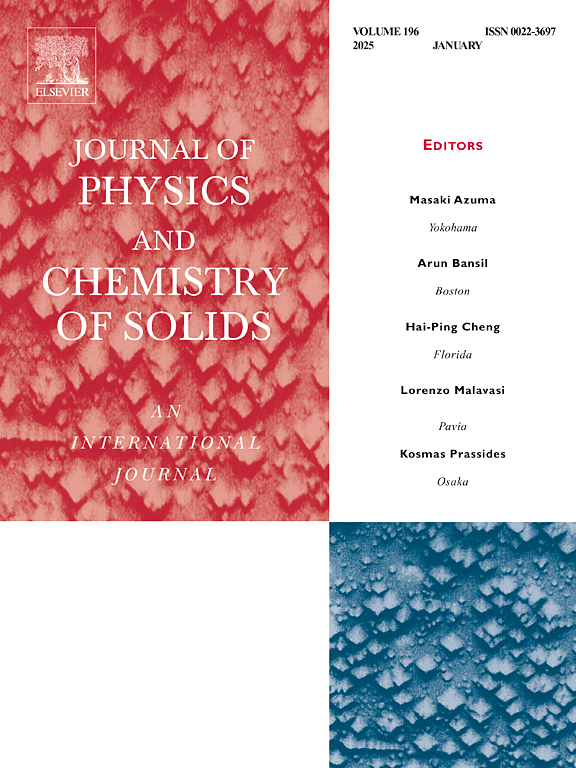Strong influence of fully quartic anharmonicity on thermoelectric properties of Li3X (X= Sb, Bi) compounds: A first principle study
IF 4.3
3区 材料科学
Q2 CHEMISTRY, MULTIDISCIPLINARY
引用次数: 0
Abstract
In this work, the thermal transport and thermoelectric properties of Li3X (X = Sb, Bi) have been systematically investigated by utilizing first-principles calculations combined with self-consistent phonon theory and Boltzmann transport equations. The fully quartic anharmonicity of Li3X is considered in the lattice thermal conductivity (κL) calculation, which encompasses temperature-driven phonon frequency shift and four-phonon (4ph) scattering. Our results indicate that fully quartic anharmonicity plays a crucial role in accurately determining the κL and the figure of merit (ZT). The acoustic phonon group velocity (υph) is enhanced due to the quartic anharmonic renormalization. The three-phonon (3ph) scattering is suppressed and an additional 4ph scattering can be introduced by self-consistent phonon theory combined with 3ph and 4ph scatterings. The phonon lifetime (τ) ultimately exhibits negligible variation. The relatively rational κL value of 1.18 and 0.94 W/(mK) are obtained at 900 K for Li3Sb and Li3Bi crystals, respectively. Meanwhile, the coexistence of the large dispersion and high degeneracy in the electronic structure capture a big power factor. Thus, we obtain high ZT peak values of 1.56 and 2.25 for the p-type Li3Sb and Li3Bi materials at 900 K, respectively. The superior value 2.25 exceeding 2 indicates the great potential of p-type Li3Bi in thermoelectric applications. These findings help us to well understand the microcosmic mechanism of thermoelectric properties in Li3X, and give useful insights into the role of the fully quartic anharmonicity for thermoelectric properties of Li3X.

全四次不谐性对Li3X (X= Sb, Bi)化合物热电性质的强烈影响:第一性原理研究
本文利用第一性原理计算,结合自一致声子理论和玻尔兹曼输运方程,系统地研究了Li3X (X = Sb, Bi)的热输运和热电性质。在晶格导热系数(κL)计算中考虑了Li3X的全四次非谐性,包括温度驱动声子频移和四声子(4ph)散射。我们的结果表明,全四次非谐波性在准确确定κL和品质图(ZT)方面起着至关重要的作用。由于四次非谐波重整化,声子群速度(ph)得到提高。通过自一致声子理论结合3ph和4ph散射,可以抑制三声子(3ph)散射,并引入额外的4ph散射。声子寿命(τ)最终表现出可以忽略不计的变化。在900 K时,Li3Sb和Li3Bi晶体的κL值分别为1.18和0.94 W/(mK)。同时,大色散和高简并度在电子结构中的共存也获得了很大的功率因数。因此,我们在900 K时获得了p型Li3Sb和Li3Bi材料的高ZT峰值,分别为1.56和2.25。p型Li3Bi的优势值2.25大于2,表明其在热电应用方面具有很大的潜力。这些发现有助于我们很好地理解Li3X热电性质的微观机制,并对Li3X热电性质的全四次非调和性的作用提供有用的见解。
本文章由计算机程序翻译,如有差异,请以英文原文为准。
求助全文
约1分钟内获得全文
求助全文
来源期刊
CiteScore
7.80
自引率
2.50%
发文量
605
审稿时长
40 days
期刊介绍:
The Journal of Physics and Chemistry of Solids is a well-established international medium for publication of archival research in condensed matter and materials sciences. Areas of interest broadly include experimental and theoretical research on electronic, magnetic, spectroscopic and structural properties as well as the statistical mechanics and thermodynamics of materials. The focus is on gaining physical and chemical insight into the properties and potential applications of condensed matter systems.
Within the broad scope of the journal, beyond regular contributions, the editors have identified submissions in the following areas of physics and chemistry of solids to be of special current interest to the journal:
Low-dimensional systems
Exotic states of quantum electron matter including topological phases
Energy conversion and storage
Interfaces, nanoparticles and catalysts.

 求助内容:
求助内容: 应助结果提醒方式:
应助结果提醒方式:


